Genetic Techniques and Ethical Considerations
VerifiedAdded on 2023/06/11
|7
|1867
|396
AI Summary
This article discusses CRISPR-Cas9 technology and its potential applications in genetic manipulation. It also highlights the ethical concerns related to germline editing and the risks associated with CRISPR-Cas9 technology. The article provides references to support the discussion.
Contribute Materials
Your contribution can guide someone’s learning journey. Share your
documents today.

Running head: BIOL202 ASSESSMENT TASK 2
Genetic techniques and ethical considerations
Name of the Student
Name of the University
Author Note
Genetic techniques and ethical considerations
Name of the Student
Name of the University
Author Note
Secure Best Marks with AI Grader
Need help grading? Try our AI Grader for instant feedback on your assignments.
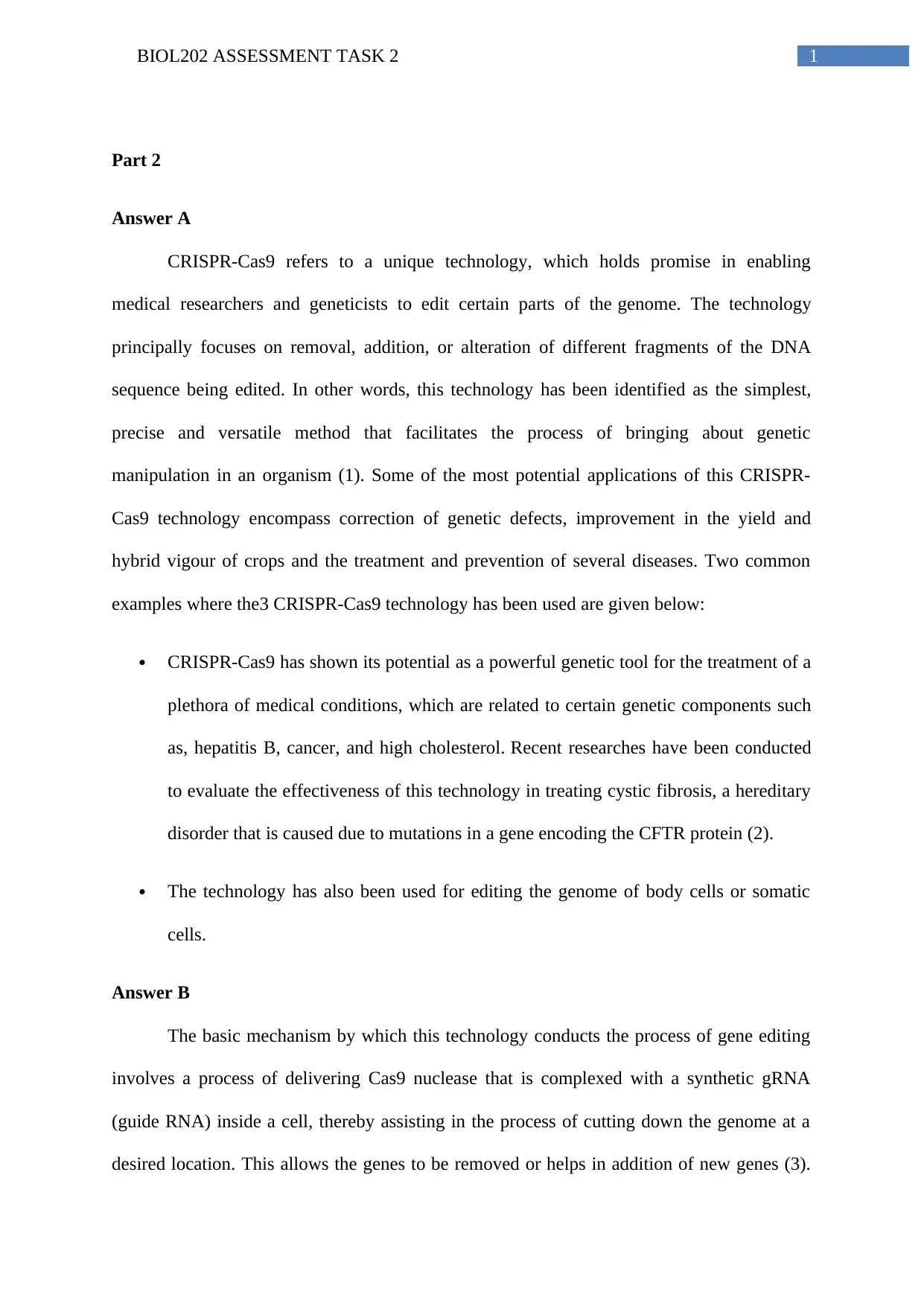
1BIOL202 ASSESSMENT TASK 2
Part 2
Answer A
CRISPR-Cas9 refers to a unique technology, which holds promise in enabling
medical researchers and geneticists to edit certain parts of the genome. The technology
principally focuses on removal, addition, or alteration of different fragments of the DNA
sequence being edited. In other words, this technology has been identified as the simplest,
precise and versatile method that facilitates the process of bringing about genetic
manipulation in an organism (1). Some of the most potential applications of this CRISPR-
Cas9 technology encompass correction of genetic defects, improvement in the yield and
hybrid vigour of crops and the treatment and prevention of several diseases. Two common
examples where the3 CRISPR-Cas9 technology has been used are given below:
CRISPR-Cas9 has shown its potential as a powerful genetic tool for the treatment of a
plethora of medical conditions, which are related to certain genetic components such
as, hepatitis B, cancer, and high cholesterol. Recent researches have been conducted
to evaluate the effectiveness of this technology in treating cystic fibrosis, a hereditary
disorder that is caused due to mutations in a gene encoding the CFTR protein (2).
The technology has also been used for editing the genome of body cells or somatic
cells.
Answer B
The basic mechanism by which this technology conducts the process of gene editing
involves a process of delivering Cas9 nuclease that is complexed with a synthetic gRNA
(guide RNA) inside a cell, thereby assisting in the process of cutting down the genome at a
desired location. This allows the genes to be removed or helps in addition of new genes (3).
Part 2
Answer A
CRISPR-Cas9 refers to a unique technology, which holds promise in enabling
medical researchers and geneticists to edit certain parts of the genome. The technology
principally focuses on removal, addition, or alteration of different fragments of the DNA
sequence being edited. In other words, this technology has been identified as the simplest,
precise and versatile method that facilitates the process of bringing about genetic
manipulation in an organism (1). Some of the most potential applications of this CRISPR-
Cas9 technology encompass correction of genetic defects, improvement in the yield and
hybrid vigour of crops and the treatment and prevention of several diseases. Two common
examples where the3 CRISPR-Cas9 technology has been used are given below:
CRISPR-Cas9 has shown its potential as a powerful genetic tool for the treatment of a
plethora of medical conditions, which are related to certain genetic components such
as, hepatitis B, cancer, and high cholesterol. Recent researches have been conducted
to evaluate the effectiveness of this technology in treating cystic fibrosis, a hereditary
disorder that is caused due to mutations in a gene encoding the CFTR protein (2).
The technology has also been used for editing the genome of body cells or somatic
cells.
Answer B
The basic mechanism by which this technology conducts the process of gene editing
involves a process of delivering Cas9 nuclease that is complexed with a synthetic gRNA
(guide RNA) inside a cell, thereby assisting in the process of cutting down the genome at a
desired location. This allows the genes to be removed or helps in addition of new genes (3).
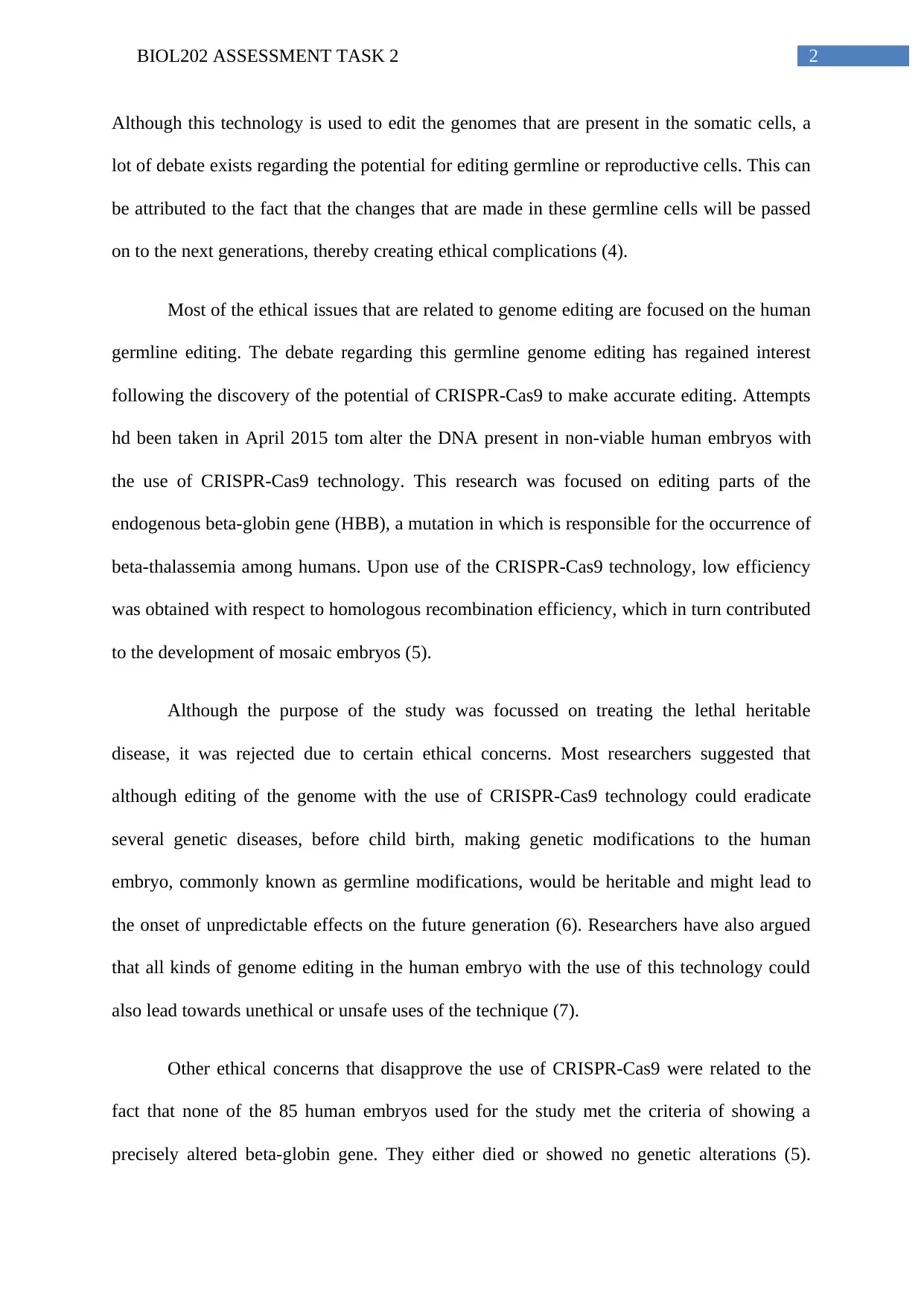
2BIOL202 ASSESSMENT TASK 2
Although this technology is used to edit the genomes that are present in the somatic cells, a
lot of debate exists regarding the potential for editing germline or reproductive cells. This can
be attributed to the fact that the changes that are made in these germline cells will be passed
on to the next generations, thereby creating ethical complications (4).
Most of the ethical issues that are related to genome editing are focused on the human
germline editing. The debate regarding this germline genome editing has regained interest
following the discovery of the potential of CRISPR-Cas9 to make accurate editing. Attempts
hd been taken in April 2015 tom alter the DNA present in non-viable human embryos with
the use of CRISPR-Cas9 technology. This research was focused on editing parts of the
endogenous beta-globin gene (HBB), a mutation in which is responsible for the occurrence of
beta-thalassemia among humans. Upon use of the CRISPR-Cas9 technology, low efficiency
was obtained with respect to homologous recombination efficiency, which in turn contributed
to the development of mosaic embryos (5).
Although the purpose of the study was focussed on treating the lethal heritable
disease, it was rejected due to certain ethical concerns. Most researchers suggested that
although editing of the genome with the use of CRISPR-Cas9 technology could eradicate
several genetic diseases, before child birth, making genetic modifications to the human
embryo, commonly known as germline modifications, would be heritable and might lead to
the onset of unpredictable effects on the future generation (6). Researchers have also argued
that all kinds of genome editing in the human embryo with the use of this technology could
also lead towards unethical or unsafe uses of the technique (7).
Other ethical concerns that disapprove the use of CRISPR-Cas9 were related to the
fact that none of the 85 human embryos used for the study met the criteria of showing a
precisely altered beta-globin gene. They either died or showed no genetic alterations (5).
Although this technology is used to edit the genomes that are present in the somatic cells, a
lot of debate exists regarding the potential for editing germline or reproductive cells. This can
be attributed to the fact that the changes that are made in these germline cells will be passed
on to the next generations, thereby creating ethical complications (4).
Most of the ethical issues that are related to genome editing are focused on the human
germline editing. The debate regarding this germline genome editing has regained interest
following the discovery of the potential of CRISPR-Cas9 to make accurate editing. Attempts
hd been taken in April 2015 tom alter the DNA present in non-viable human embryos with
the use of CRISPR-Cas9 technology. This research was focused on editing parts of the
endogenous beta-globin gene (HBB), a mutation in which is responsible for the occurrence of
beta-thalassemia among humans. Upon use of the CRISPR-Cas9 technology, low efficiency
was obtained with respect to homologous recombination efficiency, which in turn contributed
to the development of mosaic embryos (5).
Although the purpose of the study was focussed on treating the lethal heritable
disease, it was rejected due to certain ethical concerns. Most researchers suggested that
although editing of the genome with the use of CRISPR-Cas9 technology could eradicate
several genetic diseases, before child birth, making genetic modifications to the human
embryo, commonly known as germline modifications, would be heritable and might lead to
the onset of unpredictable effects on the future generation (6). Researchers have also argued
that all kinds of genome editing in the human embryo with the use of this technology could
also lead towards unethical or unsafe uses of the technique (7).
Other ethical concerns that disapprove the use of CRISPR-Cas9 were related to the
fact that none of the 85 human embryos used for the study met the criteria of showing a
precisely altered beta-globin gene. They either died or showed no genetic alterations (5).
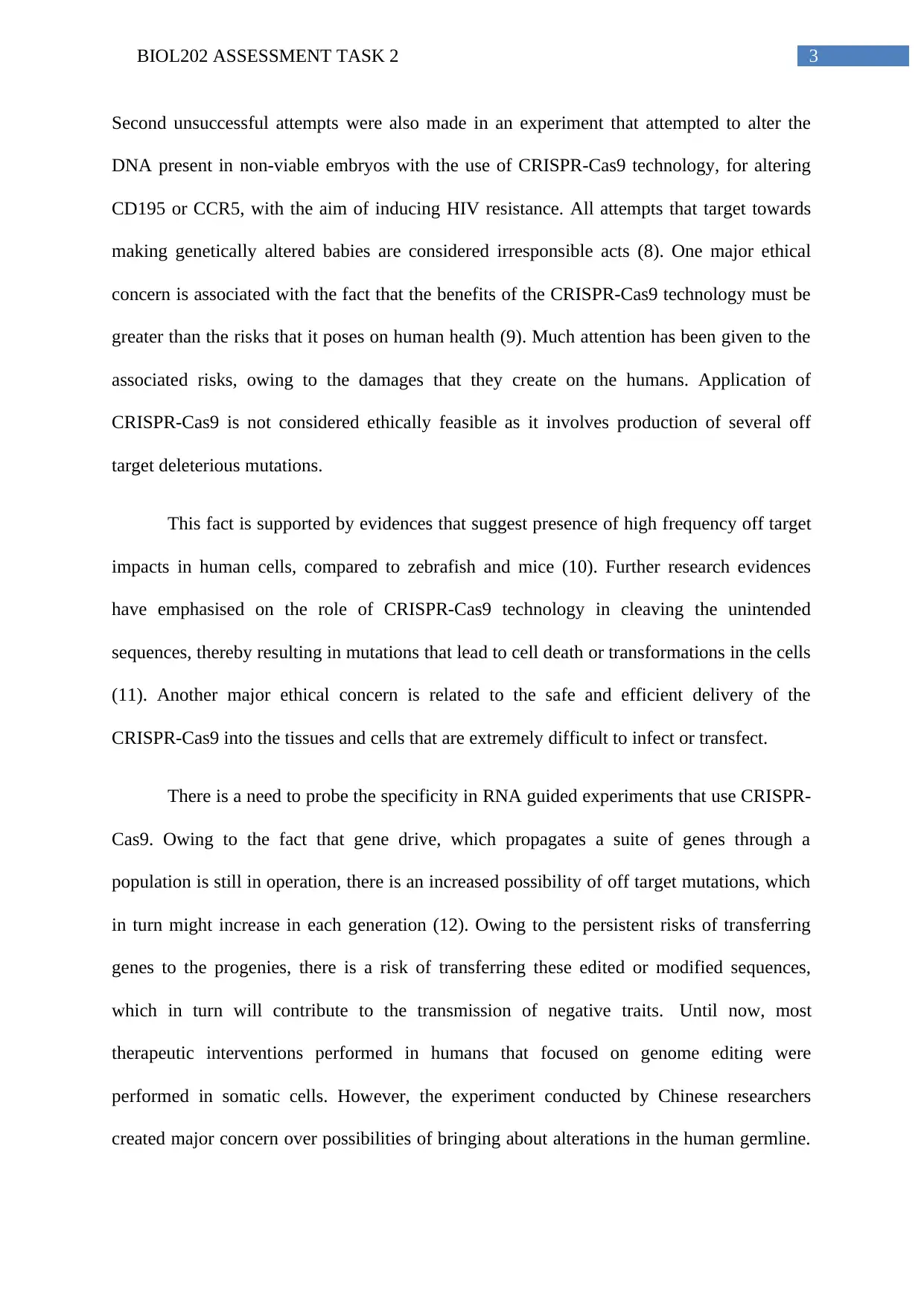
3BIOL202 ASSESSMENT TASK 2
Second unsuccessful attempts were also made in an experiment that attempted to alter the
DNA present in non-viable embryos with the use of CRISPR-Cas9 technology, for altering
CD195 or CCR5, with the aim of inducing HIV resistance. All attempts that target towards
making genetically altered babies are considered irresponsible acts (8). One major ethical
concern is associated with the fact that the benefits of the CRISPR-Cas9 technology must be
greater than the risks that it poses on human health (9). Much attention has been given to the
associated risks, owing to the damages that they create on the humans. Application of
CRISPR-Cas9 is not considered ethically feasible as it involves production of several off
target deleterious mutations.
This fact is supported by evidences that suggest presence of high frequency off target
impacts in human cells, compared to zebrafish and mice (10). Further research evidences
have emphasised on the role of CRISPR-Cas9 technology in cleaving the unintended
sequences, thereby resulting in mutations that lead to cell death or transformations in the cells
(11). Another major ethical concern is related to the safe and efficient delivery of the
CRISPR-Cas9 into the tissues and cells that are extremely difficult to infect or transfect.
There is a need to probe the specificity in RNA guided experiments that use CRISPR-
Cas9. Owing to the fact that gene drive, which propagates a suite of genes through a
population is still in operation, there is an increased possibility of off target mutations, which
in turn might increase in each generation (12). Owing to the persistent risks of transferring
genes to the progenies, there is a risk of transferring these edited or modified sequences,
which in turn will contribute to the transmission of negative traits. Until now, most
therapeutic interventions performed in humans that focused on genome editing were
performed in somatic cells. However, the experiment conducted by Chinese researchers
created major concern over possibilities of bringing about alterations in the human germline.
Second unsuccessful attempts were also made in an experiment that attempted to alter the
DNA present in non-viable embryos with the use of CRISPR-Cas9 technology, for altering
CD195 or CCR5, with the aim of inducing HIV resistance. All attempts that target towards
making genetically altered babies are considered irresponsible acts (8). One major ethical
concern is associated with the fact that the benefits of the CRISPR-Cas9 technology must be
greater than the risks that it poses on human health (9). Much attention has been given to the
associated risks, owing to the damages that they create on the humans. Application of
CRISPR-Cas9 is not considered ethically feasible as it involves production of several off
target deleterious mutations.
This fact is supported by evidences that suggest presence of high frequency off target
impacts in human cells, compared to zebrafish and mice (10). Further research evidences
have emphasised on the role of CRISPR-Cas9 technology in cleaving the unintended
sequences, thereby resulting in mutations that lead to cell death or transformations in the cells
(11). Another major ethical concern is related to the safe and efficient delivery of the
CRISPR-Cas9 into the tissues and cells that are extremely difficult to infect or transfect.
There is a need to probe the specificity in RNA guided experiments that use CRISPR-
Cas9. Owing to the fact that gene drive, which propagates a suite of genes through a
population is still in operation, there is an increased possibility of off target mutations, which
in turn might increase in each generation (12). Owing to the persistent risks of transferring
genes to the progenies, there is a risk of transferring these edited or modified sequences,
which in turn will contribute to the transmission of negative traits. Until now, most
therapeutic interventions performed in humans that focused on genome editing were
performed in somatic cells. However, the experiment conducted by Chinese researchers
created major concern over possibilities of bringing about alterations in the human germline.
Secure Best Marks with AI Grader
Need help grading? Try our AI Grader for instant feedback on your assignments.
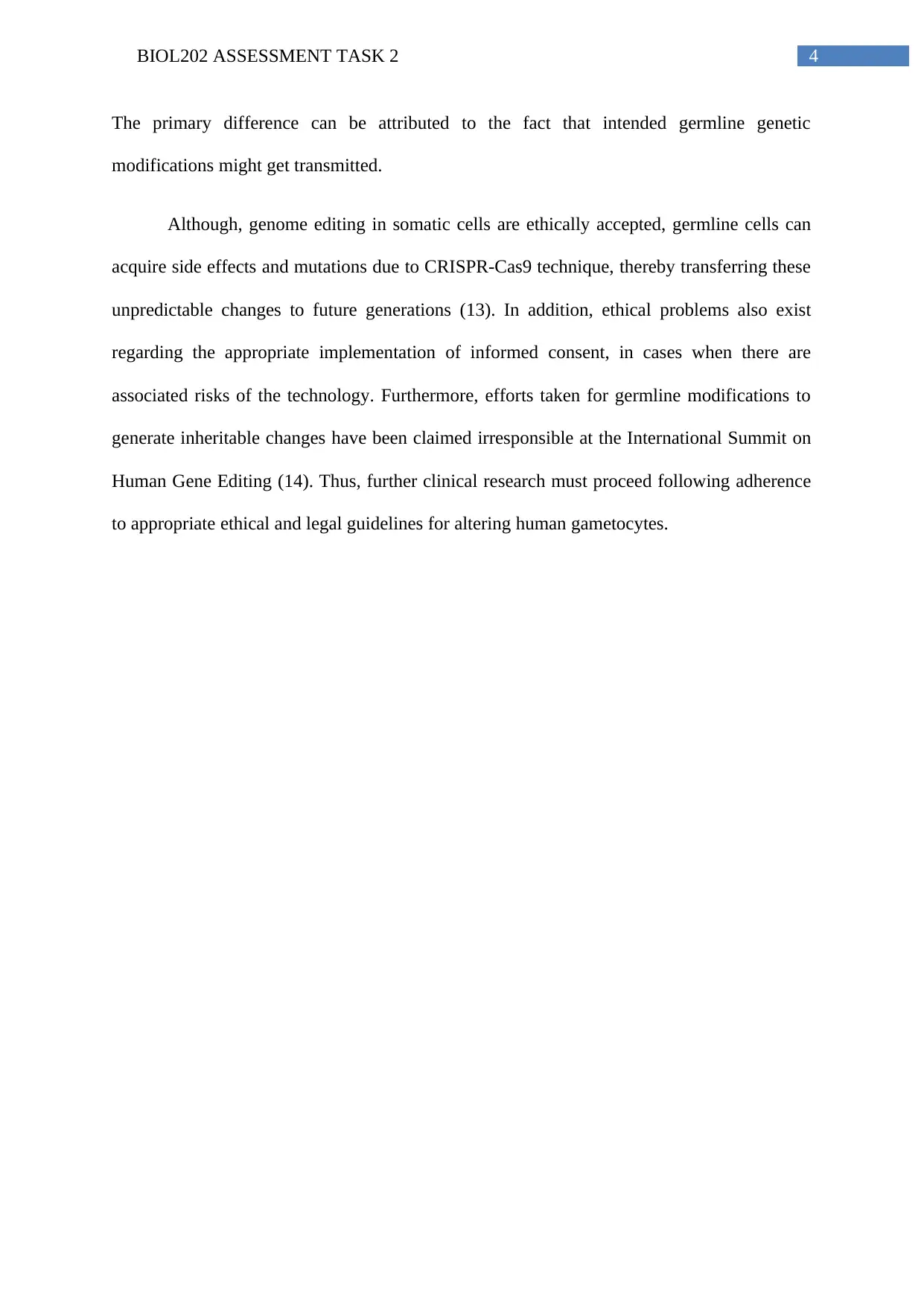
4BIOL202 ASSESSMENT TASK 2
The primary difference can be attributed to the fact that intended germline genetic
modifications might get transmitted.
Although, genome editing in somatic cells are ethically accepted, germline cells can
acquire side effects and mutations due to CRISPR-Cas9 technique, thereby transferring these
unpredictable changes to future generations (13). In addition, ethical problems also exist
regarding the appropriate implementation of informed consent, in cases when there are
associated risks of the technology. Furthermore, efforts taken for germline modifications to
generate inheritable changes have been claimed irresponsible at the International Summit on
Human Gene Editing (14). Thus, further clinical research must proceed following adherence
to appropriate ethical and legal guidelines for altering human gametocytes.
The primary difference can be attributed to the fact that intended germline genetic
modifications might get transmitted.
Although, genome editing in somatic cells are ethically accepted, germline cells can
acquire side effects and mutations due to CRISPR-Cas9 technique, thereby transferring these
unpredictable changes to future generations (13). In addition, ethical problems also exist
regarding the appropriate implementation of informed consent, in cases when there are
associated risks of the technology. Furthermore, efforts taken for germline modifications to
generate inheritable changes have been claimed irresponsible at the International Summit on
Human Gene Editing (14). Thus, further clinical research must proceed following adherence
to appropriate ethical and legal guidelines for altering human gametocytes.
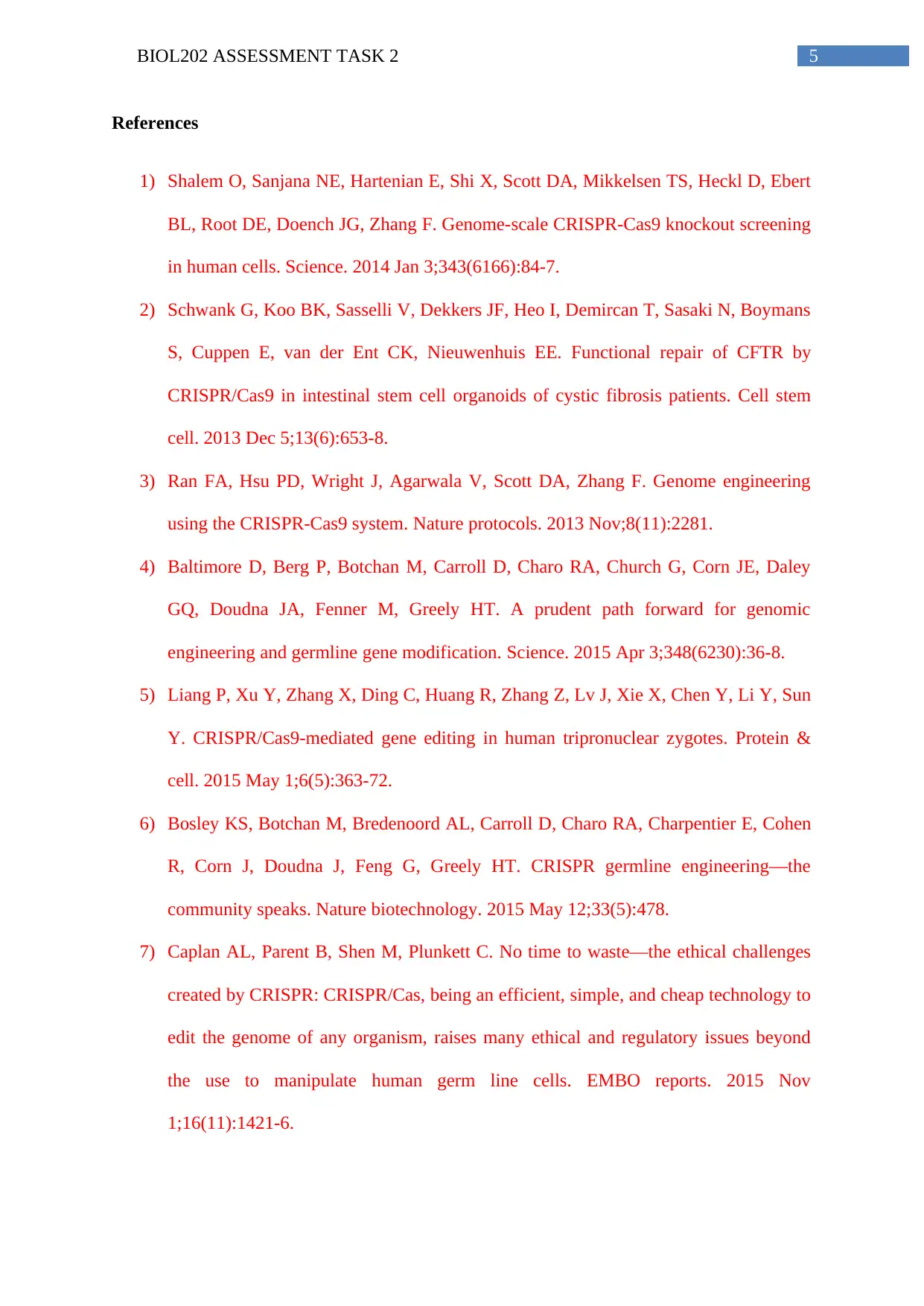
5BIOL202 ASSESSMENT TASK 2
References
1) Shalem O, Sanjana NE, Hartenian E, Shi X, Scott DA, Mikkelsen TS, Heckl D, Ebert
BL, Root DE, Doench JG, Zhang F. Genome-scale CRISPR-Cas9 knockout screening
in human cells. Science. 2014 Jan 3;343(6166):84-7.
2) Schwank G, Koo BK, Sasselli V, Dekkers JF, Heo I, Demircan T, Sasaki N, Boymans
S, Cuppen E, van der Ent CK, Nieuwenhuis EE. Functional repair of CFTR by
CRISPR/Cas9 in intestinal stem cell organoids of cystic fibrosis patients. Cell stem
cell. 2013 Dec 5;13(6):653-8.
3) Ran FA, Hsu PD, Wright J, Agarwala V, Scott DA, Zhang F. Genome engineering
using the CRISPR-Cas9 system. Nature protocols. 2013 Nov;8(11):2281.
4) Baltimore D, Berg P, Botchan M, Carroll D, Charo RA, Church G, Corn JE, Daley
GQ, Doudna JA, Fenner M, Greely HT. A prudent path forward for genomic
engineering and germline gene modification. Science. 2015 Apr 3;348(6230):36-8.
5) Liang P, Xu Y, Zhang X, Ding C, Huang R, Zhang Z, Lv J, Xie X, Chen Y, Li Y, Sun
Y. CRISPR/Cas9-mediated gene editing in human tripronuclear zygotes. Protein &
cell. 2015 May 1;6(5):363-72.
6) Bosley KS, Botchan M, Bredenoord AL, Carroll D, Charo RA, Charpentier E, Cohen
R, Corn J, Doudna J, Feng G, Greely HT. CRISPR germline engineering—the
community speaks. Nature biotechnology. 2015 May 12;33(5):478.
7) Caplan AL, Parent B, Shen M, Plunkett C. No time to waste—the ethical challenges
created by CRISPR: CRISPR/Cas, being an efficient, simple, and cheap technology to
edit the genome of any organism, raises many ethical and regulatory issues beyond
the use to manipulate human germ line cells. EMBO reports. 2015 Nov
1;16(11):1421-6.
References
1) Shalem O, Sanjana NE, Hartenian E, Shi X, Scott DA, Mikkelsen TS, Heckl D, Ebert
BL, Root DE, Doench JG, Zhang F. Genome-scale CRISPR-Cas9 knockout screening
in human cells. Science. 2014 Jan 3;343(6166):84-7.
2) Schwank G, Koo BK, Sasselli V, Dekkers JF, Heo I, Demircan T, Sasaki N, Boymans
S, Cuppen E, van der Ent CK, Nieuwenhuis EE. Functional repair of CFTR by
CRISPR/Cas9 in intestinal stem cell organoids of cystic fibrosis patients. Cell stem
cell. 2013 Dec 5;13(6):653-8.
3) Ran FA, Hsu PD, Wright J, Agarwala V, Scott DA, Zhang F. Genome engineering
using the CRISPR-Cas9 system. Nature protocols. 2013 Nov;8(11):2281.
4) Baltimore D, Berg P, Botchan M, Carroll D, Charo RA, Church G, Corn JE, Daley
GQ, Doudna JA, Fenner M, Greely HT. A prudent path forward for genomic
engineering and germline gene modification. Science. 2015 Apr 3;348(6230):36-8.
5) Liang P, Xu Y, Zhang X, Ding C, Huang R, Zhang Z, Lv J, Xie X, Chen Y, Li Y, Sun
Y. CRISPR/Cas9-mediated gene editing in human tripronuclear zygotes. Protein &
cell. 2015 May 1;6(5):363-72.
6) Bosley KS, Botchan M, Bredenoord AL, Carroll D, Charo RA, Charpentier E, Cohen
R, Corn J, Doudna J, Feng G, Greely HT. CRISPR germline engineering—the
community speaks. Nature biotechnology. 2015 May 12;33(5):478.
7) Caplan AL, Parent B, Shen M, Plunkett C. No time to waste—the ethical challenges
created by CRISPR: CRISPR/Cas, being an efficient, simple, and cheap technology to
edit the genome of any organism, raises many ethical and regulatory issues beyond
the use to manipulate human germ line cells. EMBO reports. 2015 Nov
1;16(11):1421-6.
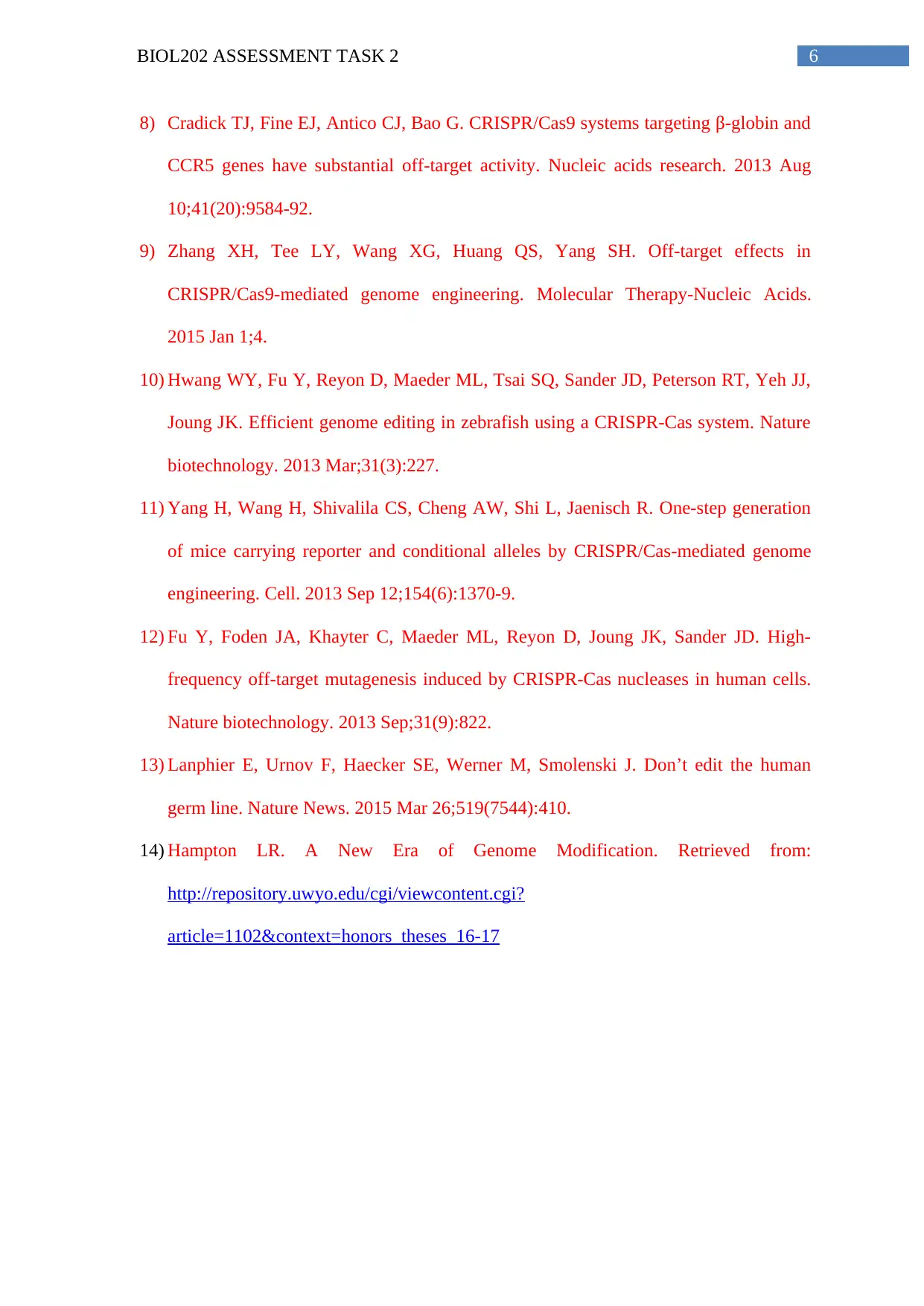
6BIOL202 ASSESSMENT TASK 2
8) Cradick TJ, Fine EJ, Antico CJ, Bao G. CRISPR/Cas9 systems targeting β-globin and
CCR5 genes have substantial off-target activity. Nucleic acids research. 2013 Aug
10;41(20):9584-92.
9) Zhang XH, Tee LY, Wang XG, Huang QS, Yang SH. Off-target effects in
CRISPR/Cas9-mediated genome engineering. Molecular Therapy-Nucleic Acids.
2015 Jan 1;4.
10) Hwang WY, Fu Y, Reyon D, Maeder ML, Tsai SQ, Sander JD, Peterson RT, Yeh JJ,
Joung JK. Efficient genome editing in zebrafish using a CRISPR-Cas system. Nature
biotechnology. 2013 Mar;31(3):227.
11) Yang H, Wang H, Shivalila CS, Cheng AW, Shi L, Jaenisch R. One-step generation
of mice carrying reporter and conditional alleles by CRISPR/Cas-mediated genome
engineering. Cell. 2013 Sep 12;154(6):1370-9.
12) Fu Y, Foden JA, Khayter C, Maeder ML, Reyon D, Joung JK, Sander JD. High-
frequency off-target mutagenesis induced by CRISPR-Cas nucleases in human cells.
Nature biotechnology. 2013 Sep;31(9):822.
13) Lanphier E, Urnov F, Haecker SE, Werner M, Smolenski J. Don’t edit the human
germ line. Nature News. 2015 Mar 26;519(7544):410.
14) Hampton LR. A New Era of Genome Modification. Retrieved from:
http://repository.uwyo.edu/cgi/viewcontent.cgi?
article=1102&context=honors_theses_16-17
8) Cradick TJ, Fine EJ, Antico CJ, Bao G. CRISPR/Cas9 systems targeting β-globin and
CCR5 genes have substantial off-target activity. Nucleic acids research. 2013 Aug
10;41(20):9584-92.
9) Zhang XH, Tee LY, Wang XG, Huang QS, Yang SH. Off-target effects in
CRISPR/Cas9-mediated genome engineering. Molecular Therapy-Nucleic Acids.
2015 Jan 1;4.
10) Hwang WY, Fu Y, Reyon D, Maeder ML, Tsai SQ, Sander JD, Peterson RT, Yeh JJ,
Joung JK. Efficient genome editing in zebrafish using a CRISPR-Cas system. Nature
biotechnology. 2013 Mar;31(3):227.
11) Yang H, Wang H, Shivalila CS, Cheng AW, Shi L, Jaenisch R. One-step generation
of mice carrying reporter and conditional alleles by CRISPR/Cas-mediated genome
engineering. Cell. 2013 Sep 12;154(6):1370-9.
12) Fu Y, Foden JA, Khayter C, Maeder ML, Reyon D, Joung JK, Sander JD. High-
frequency off-target mutagenesis induced by CRISPR-Cas nucleases in human cells.
Nature biotechnology. 2013 Sep;31(9):822.
13) Lanphier E, Urnov F, Haecker SE, Werner M, Smolenski J. Don’t edit the human
germ line. Nature News. 2015 Mar 26;519(7544):410.
14) Hampton LR. A New Era of Genome Modification. Retrieved from:
http://repository.uwyo.edu/cgi/viewcontent.cgi?
article=1102&context=honors_theses_16-17
1 out of 7
Related Documents
Your All-in-One AI-Powered Toolkit for Academic Success.
+13062052269
info@desklib.com
Available 24*7 on WhatsApp / Email
![[object Object]](/_next/static/media/star-bottom.7253800d.svg)
Unlock your academic potential
© 2024 | Zucol Services PVT LTD | All rights reserved.





